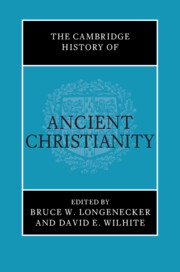Refine search
Actions for selected content:
23990 results in Ancient history
5 - Remembering Jesus in Earliest Christianity
- from Part II - Contested Figures
-
-
- Book:
- The Cambridge History of Ancient Christianity
- Published online:
- 23 August 2023
- Print publication:
- 24 August 2023, pp 109-129
-
- Chapter
- Export citation
26 - Wealth, Almsgiving, and Poverty
- from Part VI - Contested Bodies
-
-
- Book:
- The Cambridge History of Ancient Christianity
- Published online:
- 23 August 2023
- Print publication:
- 24 August 2023, pp 613-632
-
- Chapter
- Export citation
20 - The Trinity in the Making
- from Part V - Contested Beliefs
-
-
- Book:
- The Cambridge History of Ancient Christianity
- Published online:
- 23 August 2023
- Print publication:
- 24 August 2023, pp 466-490
-
- Chapter
- Export citation
Part IV - Contested Cultures
-
- Book:
- The Cambridge History of Ancient Christianity
- Published online:
- 23 August 2023
- Print publication:
- 24 August 2023, pp 323-442
-
- Chapter
- Export citation
2 - The Present and Future of Ancient Christian History
- from Part I - Contested Contexts
-
-
- Book:
- The Cambridge History of Ancient Christianity
- Published online:
- 23 August 2023
- Print publication:
- 24 August 2023, pp 32-56
-
- Chapter
- Export citation
24 - Masculinity, Femininity, and Sexuality
- from Part VI - Contested Bodies
-
-
- Book:
- The Cambridge History of Ancient Christianity
- Published online:
- 23 August 2023
- Print publication:
- 24 August 2023, pp 561-585
-
- Chapter
- Export citation
Ancient Sources
-
- Book:
- The Cambridge History of Ancient Christianity
- Published online:
- 23 August 2023
- Print publication:
- 24 August 2023, pp 659-687
-
- Chapter
- Export citation
8 - Peter and His Diverse Champions
- from Part II - Contested Figures
-
-
- Book:
- The Cambridge History of Ancient Christianity
- Published online:
- 23 August 2023
- Print publication:
- 24 August 2023, pp 175-196
-
- Chapter
- Export citation
4 - Why Did People Become Christians in the Pre-Constantinian World?
- from Part I - Contested Contexts
-
-
- Book:
- The Cambridge History of Ancient Christianity
- Published online:
- 23 August 2023
- Print publication:
- 24 August 2023, pp 80-106
-
- Chapter
- Export citation
Modern Authors
-
- Book:
- The Cambridge History of Ancient Christianity
- Published online:
- 23 August 2023
- Print publication:
- 24 August 2023, pp 688-698
-
- Chapter
- Export citation
9 - Jews and Christians in Pagan Antiquity
- from Part III - Contested Heritage
-
-
- Book:
- The Cambridge History of Ancient Christianity
- Published online:
- 23 August 2023
- Print publication:
- 24 August 2023, pp 199-227
-
- Chapter
- Export citation
Copyright page
-
- Book:
- The Cambridge History of Ancient Christianity
- Published online:
- 23 August 2023
- Print publication:
- 24 August 2023, pp iv-iv
-
- Chapter
- Export citation
17 - The Emergence(s) of Christian Material Culture(s)
- from Part IV - Contested Cultures
-
-
- Book:
- The Cambridge History of Ancient Christianity
- Published online:
- 23 August 2023
- Print publication:
- 24 August 2023, pp 396-418
-
- Chapter
- Export citation
Part V - Contested Beliefs
-
- Book:
- The Cambridge History of Ancient Christianity
- Published online:
- 23 August 2023
- Print publication:
- 24 August 2023, pp 443-558
-
- Chapter
- Export citation
15 - Early Christians and Roman Imperial Ideology
- from Part IV - Contested Cultures
-
-
- Book:
- The Cambridge History of Ancient Christianity
- Published online:
- 23 August 2023
- Print publication:
- 24 August 2023, pp 347-371
-
- Chapter
- Export citation
11 - The Gnostic Options
- from Part III - Contested Heritage
-
-
- Book:
- The Cambridge History of Ancient Christianity
- Published online:
- 23 August 2023
- Print publication:
- 24 August 2023, pp 250-275
-
- Chapter
- Export citation
21 - Resurrection, Transformation, and Deification
- from Part V - Contested Beliefs
-
-
- Book:
- The Cambridge History of Ancient Christianity
- Published online:
- 23 August 2023
- Print publication:
- 24 August 2023, pp 491-513
-
- Chapter
- Export citation
1 - The History of Ancient Christian History
- from Part I - Contested Contexts
-
-
- Book:
- The Cambridge History of Ancient Christianity
- Published online:
- 23 August 2023
- Print publication:
- 24 August 2023, pp 3-31
-
- Chapter
- Export citation
25 - Christian Slavery in Theology and Practice
- from Part VI - Contested Bodies
-
-
- Book:
- The Cambridge History of Ancient Christianity
- Published online:
- 23 August 2023
- Print publication:
- 24 August 2023, pp 586-612
-
- Chapter
- Export citation

The Cambridge History of Ancient Christianity
-
- Published online:
- 23 August 2023
- Print publication:
- 24 August 2023
